Fundamentals of Accounting: Principles and Concepts Analysis
VerifiedAdded on 2020/05/16
|7
|1352
|257
Homework Assignment
AI Summary
This assignment provides a detailed analysis of the fundamental principles and concepts of accounting. It begins by outlining the five major underlying assumptions, including business entity, going concern, periodicity, money measurement, and stable dollar. The assignment then explores the concepts impacting the accounting process, such as accrual, consistency, conservatism, matching, and the double-entry concept. It further delves into the five major accounting principles: exchange price, revenue recognition, matching, gain and loss recognition, and the full disclosure principle. The assignment also covers modifying conventions like cost-benefit, materiality, and conservatism, explaining how these practices impact the application of accounting principles. Finally, it provides examples applying these principles to various scenarios, reinforcing the understanding of core accounting concepts.
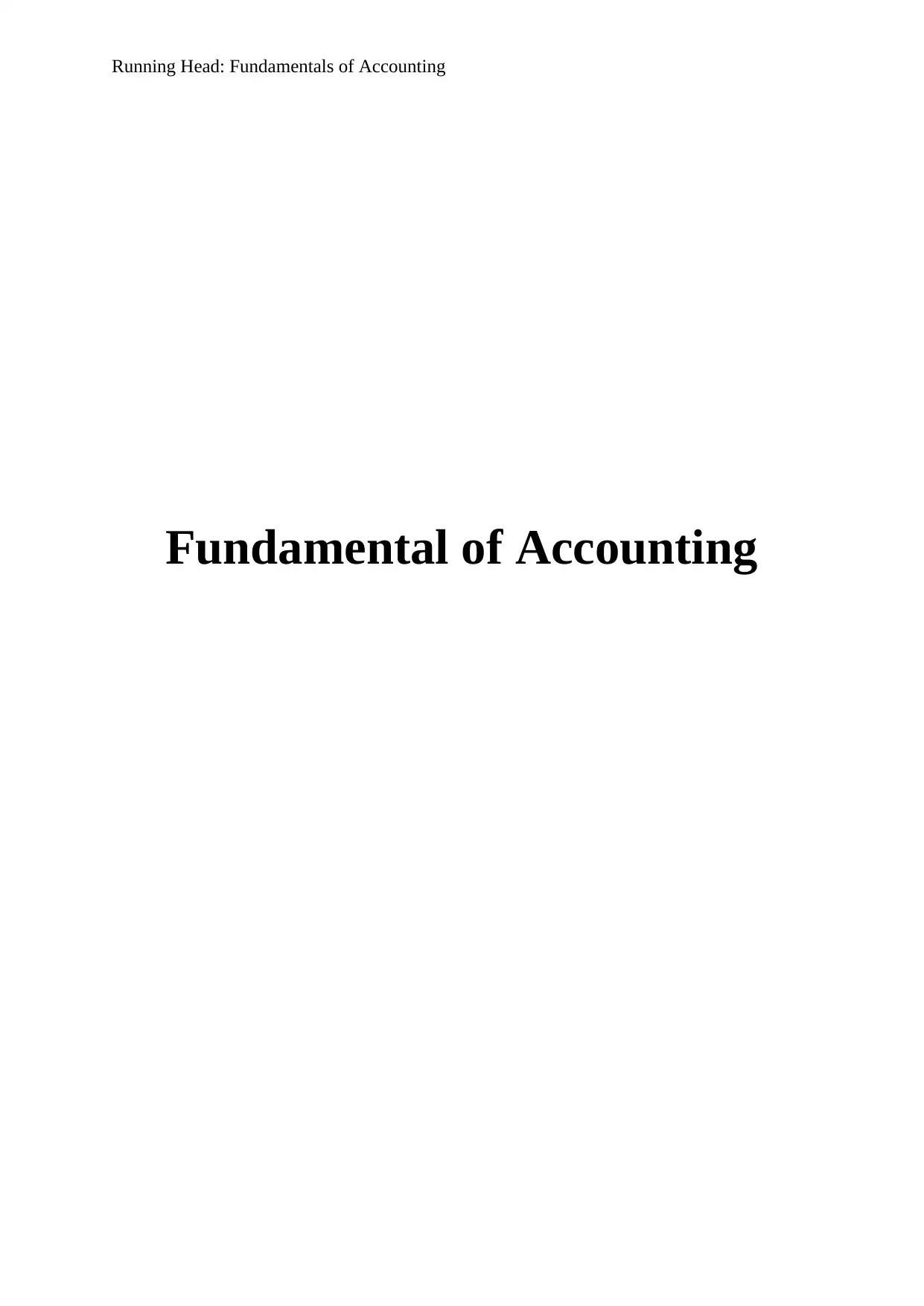
Running Head: Fundamentals of Accounting
Fundamental of Accounting
Fundamental of Accounting
Paraphrase This Document
Need a fresh take? Get an instant paraphrase of this document with our AI Paraphraser
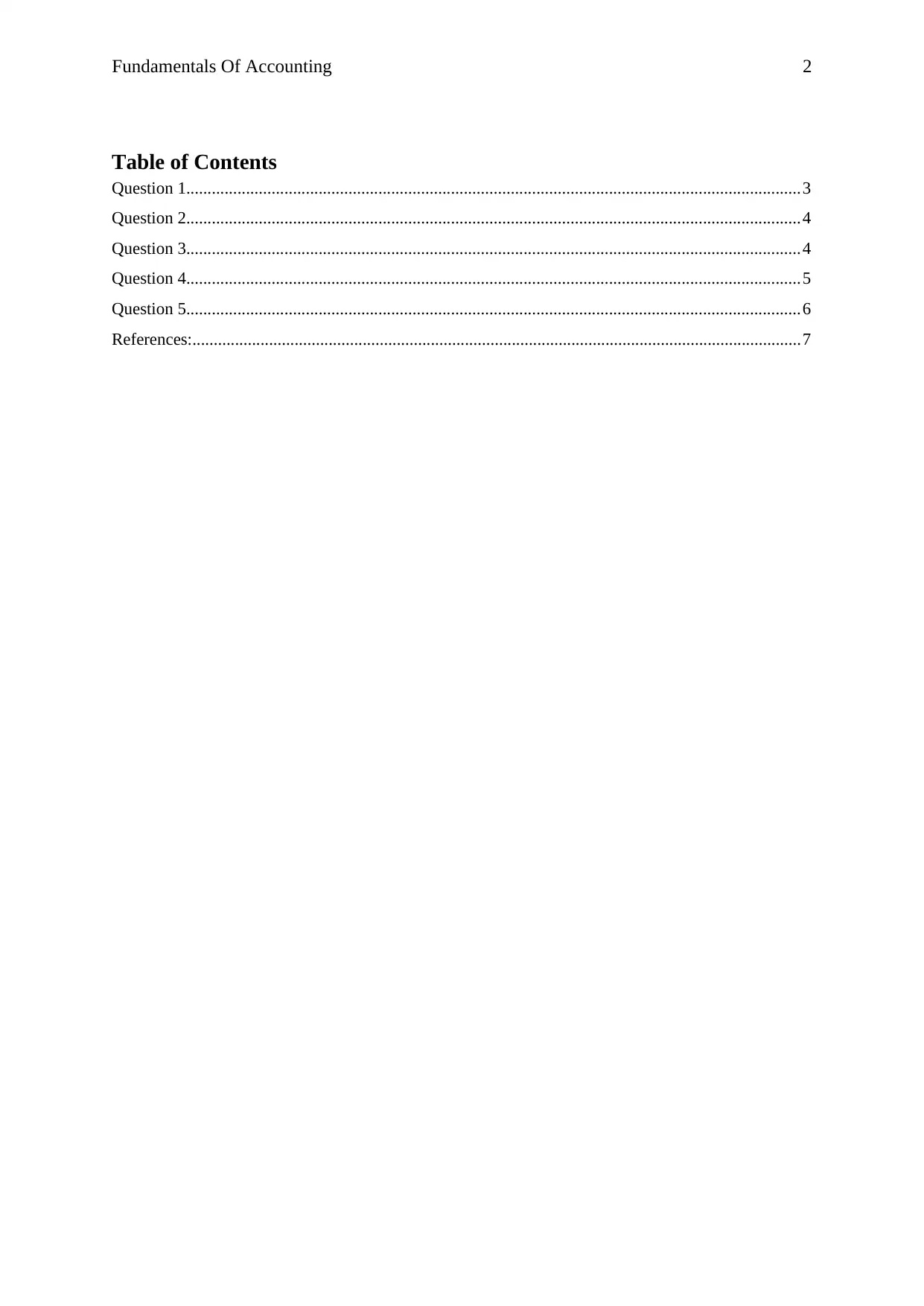
Fundamentals Of Accounting 2
Table of Contents
Question 1................................................................................................................................................3
Question 2................................................................................................................................................4
Question 3................................................................................................................................................4
Question 4................................................................................................................................................5
Question 5................................................................................................................................................6
References:...............................................................................................................................................7
Table of Contents
Question 1................................................................................................................................................3
Question 2................................................................................................................................................4
Question 3................................................................................................................................................4
Question 4................................................................................................................................................5
Question 5................................................................................................................................................6
References:...............................................................................................................................................7
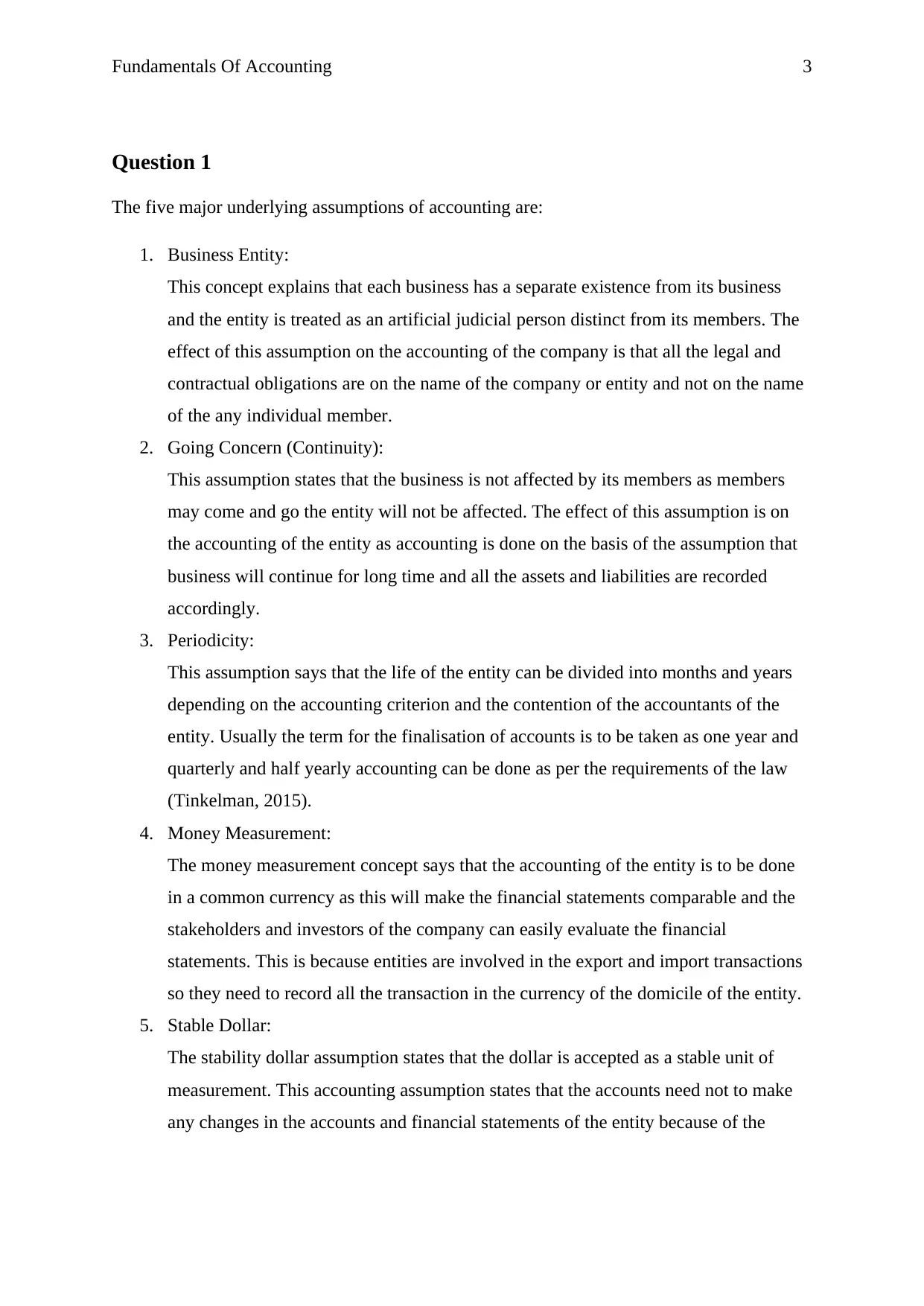
Fundamentals Of Accounting 3
Question 1
The five major underlying assumptions of accounting are:
1. Business Entity:
This concept explains that each business has a separate existence from its business
and the entity is treated as an artificial judicial person distinct from its members. The
effect of this assumption on the accounting of the company is that all the legal and
contractual obligations are on the name of the company or entity and not on the name
of the any individual member.
2. Going Concern (Continuity):
This assumption states that the business is not affected by its members as members
may come and go the entity will not be affected. The effect of this assumption is on
the accounting of the entity as accounting is done on the basis of the assumption that
business will continue for long time and all the assets and liabilities are recorded
accordingly.
3. Periodicity:
This assumption says that the life of the entity can be divided into months and years
depending on the accounting criterion and the contention of the accountants of the
entity. Usually the term for the finalisation of accounts is to be taken as one year and
quarterly and half yearly accounting can be done as per the requirements of the law
(Tinkelman, 2015).
4. Money Measurement:
The money measurement concept says that the accounting of the entity is to be done
in a common currency as this will make the financial statements comparable and the
stakeholders and investors of the company can easily evaluate the financial
statements. This is because entities are involved in the export and import transactions
so they need to record all the transaction in the currency of the domicile of the entity.
5. Stable Dollar:
The stability dollar assumption states that the dollar is accepted as a stable unit of
measurement. This accounting assumption states that the accounts need not to make
any changes in the accounts and financial statements of the entity because of the
Question 1
The five major underlying assumptions of accounting are:
1. Business Entity:
This concept explains that each business has a separate existence from its business
and the entity is treated as an artificial judicial person distinct from its members. The
effect of this assumption on the accounting of the company is that all the legal and
contractual obligations are on the name of the company or entity and not on the name
of the any individual member.
2. Going Concern (Continuity):
This assumption states that the business is not affected by its members as members
may come and go the entity will not be affected. The effect of this assumption is on
the accounting of the entity as accounting is done on the basis of the assumption that
business will continue for long time and all the assets and liabilities are recorded
accordingly.
3. Periodicity:
This assumption says that the life of the entity can be divided into months and years
depending on the accounting criterion and the contention of the accountants of the
entity. Usually the term for the finalisation of accounts is to be taken as one year and
quarterly and half yearly accounting can be done as per the requirements of the law
(Tinkelman, 2015).
4. Money Measurement:
The money measurement concept says that the accounting of the entity is to be done
in a common currency as this will make the financial statements comparable and the
stakeholders and investors of the company can easily evaluate the financial
statements. This is because entities are involved in the export and import transactions
so they need to record all the transaction in the currency of the domicile of the entity.
5. Stable Dollar:
The stability dollar assumption states that the dollar is accepted as a stable unit of
measurement. This accounting assumption states that the accounts need not to make
any changes in the accounts and financial statements of the entity because of the
⊘ This is a preview!⊘
Do you want full access?
Subscribe today to unlock all pages.

Trusted by 1+ million students worldwide
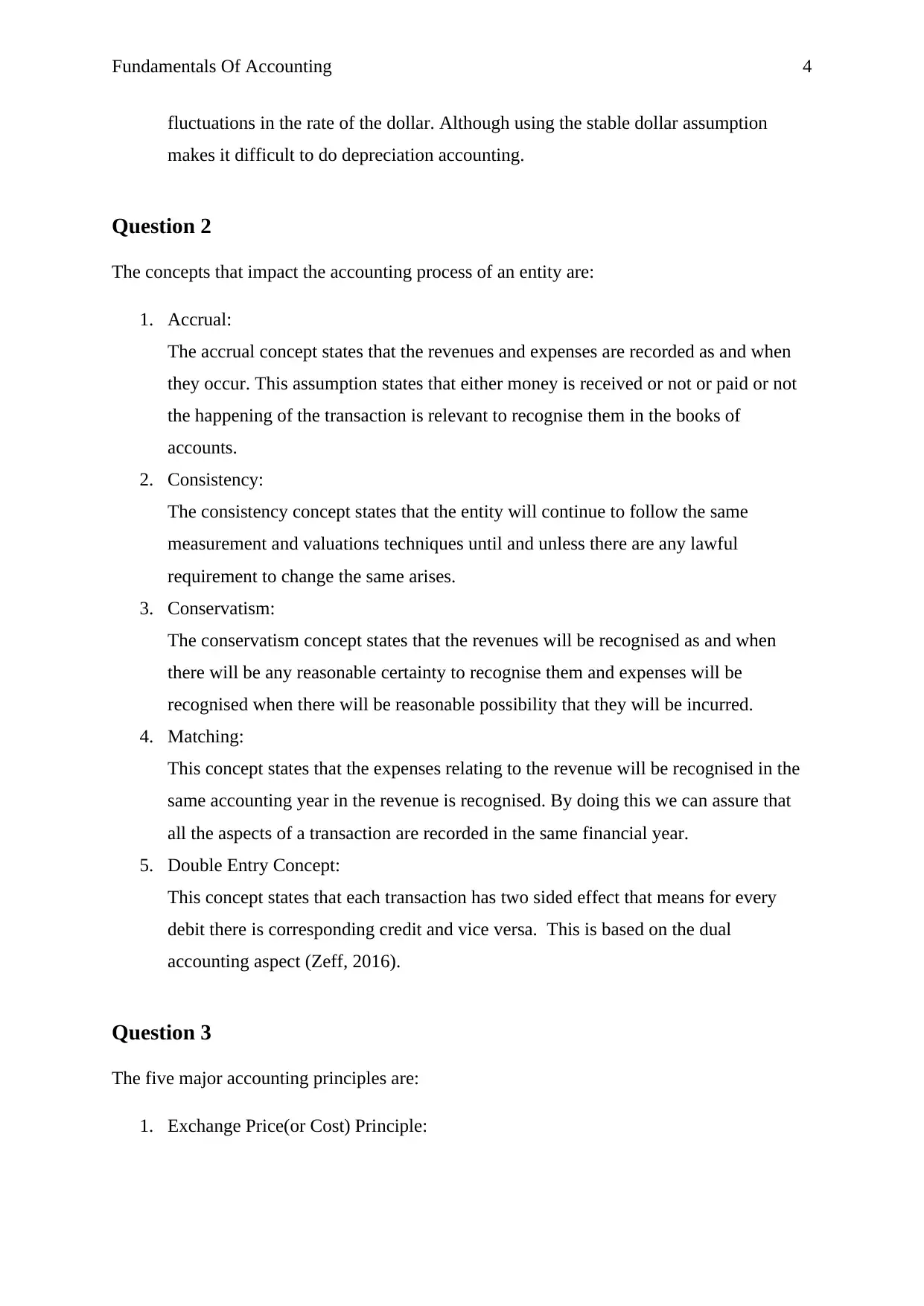
Fundamentals Of Accounting 4
fluctuations in the rate of the dollar. Although using the stable dollar assumption
makes it difficult to do depreciation accounting.
Question 2
The concepts that impact the accounting process of an entity are:
1. Accrual:
The accrual concept states that the revenues and expenses are recorded as and when
they occur. This assumption states that either money is received or not or paid or not
the happening of the transaction is relevant to recognise them in the books of
accounts.
2. Consistency:
The consistency concept states that the entity will continue to follow the same
measurement and valuations techniques until and unless there are any lawful
requirement to change the same arises.
3. Conservatism:
The conservatism concept states that the revenues will be recognised as and when
there will be any reasonable certainty to recognise them and expenses will be
recognised when there will be reasonable possibility that they will be incurred.
4. Matching:
This concept states that the expenses relating to the revenue will be recognised in the
same accounting year in the revenue is recognised. By doing this we can assure that
all the aspects of a transaction are recorded in the same financial year.
5. Double Entry Concept:
This concept states that each transaction has two sided effect that means for every
debit there is corresponding credit and vice versa. This is based on the dual
accounting aspect (Zeff, 2016).
Question 3
The five major accounting principles are:
1. Exchange Price(or Cost) Principle:
fluctuations in the rate of the dollar. Although using the stable dollar assumption
makes it difficult to do depreciation accounting.
Question 2
The concepts that impact the accounting process of an entity are:
1. Accrual:
The accrual concept states that the revenues and expenses are recorded as and when
they occur. This assumption states that either money is received or not or paid or not
the happening of the transaction is relevant to recognise them in the books of
accounts.
2. Consistency:
The consistency concept states that the entity will continue to follow the same
measurement and valuations techniques until and unless there are any lawful
requirement to change the same arises.
3. Conservatism:
The conservatism concept states that the revenues will be recognised as and when
there will be any reasonable certainty to recognise them and expenses will be
recognised when there will be reasonable possibility that they will be incurred.
4. Matching:
This concept states that the expenses relating to the revenue will be recognised in the
same accounting year in the revenue is recognised. By doing this we can assure that
all the aspects of a transaction are recorded in the same financial year.
5. Double Entry Concept:
This concept states that each transaction has two sided effect that means for every
debit there is corresponding credit and vice versa. This is based on the dual
accounting aspect (Zeff, 2016).
Question 3
The five major accounting principles are:
1. Exchange Price(or Cost) Principle:
Paraphrase This Document
Need a fresh take? Get an instant paraphrase of this document with our AI Paraphraser
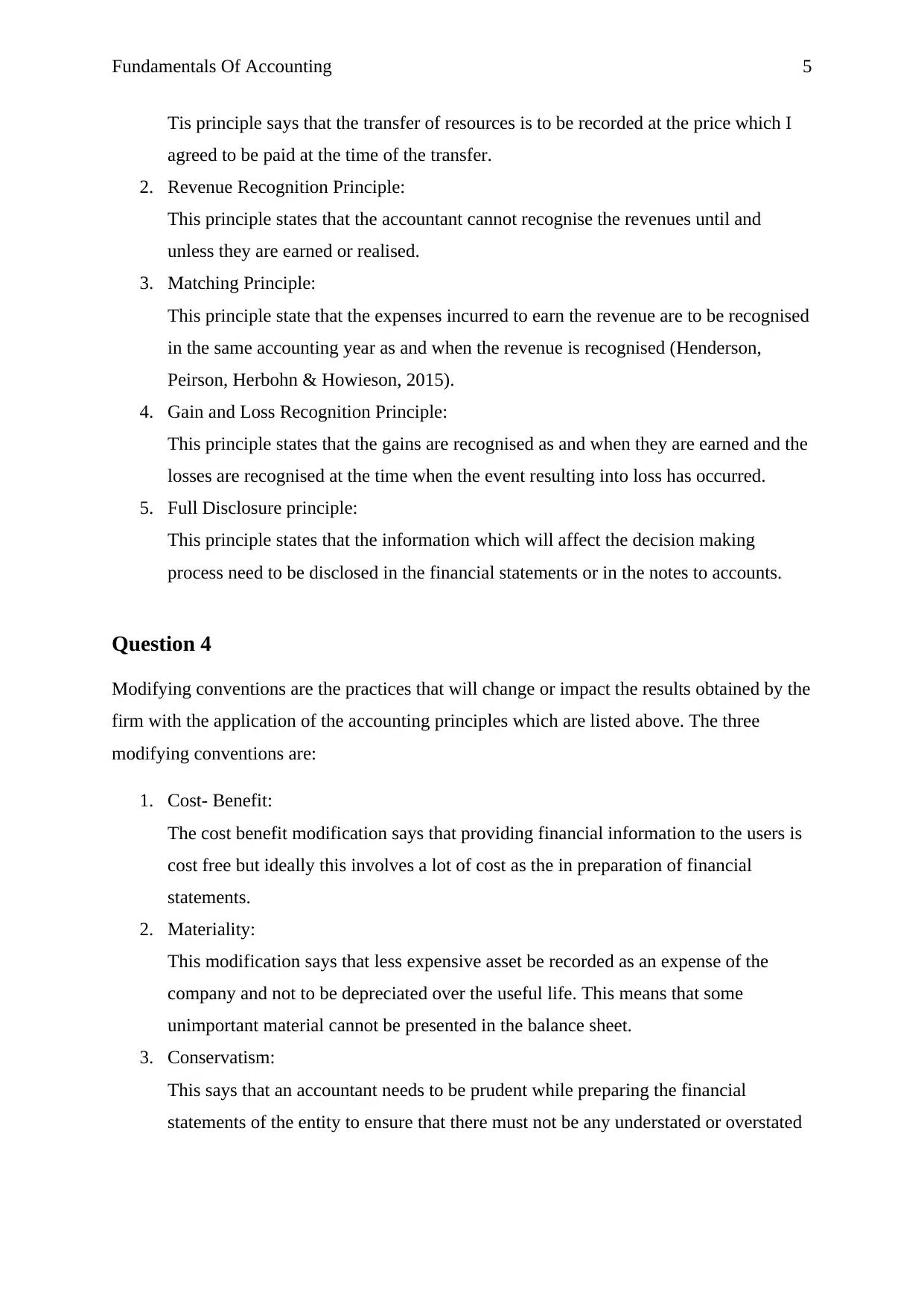
Fundamentals Of Accounting 5
Tis principle says that the transfer of resources is to be recorded at the price which I
agreed to be paid at the time of the transfer.
2. Revenue Recognition Principle:
This principle states that the accountant cannot recognise the revenues until and
unless they are earned or realised.
3. Matching Principle:
This principle state that the expenses incurred to earn the revenue are to be recognised
in the same accounting year as and when the revenue is recognised (Henderson,
Peirson, Herbohn & Howieson, 2015).
4. Gain and Loss Recognition Principle:
This principle states that the gains are recognised as and when they are earned and the
losses are recognised at the time when the event resulting into loss has occurred.
5. Full Disclosure principle:
This principle states that the information which will affect the decision making
process need to be disclosed in the financial statements or in the notes to accounts.
Question 4
Modifying conventions are the practices that will change or impact the results obtained by the
firm with the application of the accounting principles which are listed above. The three
modifying conventions are:
1. Cost- Benefit:
The cost benefit modification says that providing financial information to the users is
cost free but ideally this involves a lot of cost as the in preparation of financial
statements.
2. Materiality:
This modification says that less expensive asset be recorded as an expense of the
company and not to be depreciated over the useful life. This means that some
unimportant material cannot be presented in the balance sheet.
3. Conservatism:
This says that an accountant needs to be prudent while preparing the financial
statements of the entity to ensure that there must not be any understated or overstated
Tis principle says that the transfer of resources is to be recorded at the price which I
agreed to be paid at the time of the transfer.
2. Revenue Recognition Principle:
This principle states that the accountant cannot recognise the revenues until and
unless they are earned or realised.
3. Matching Principle:
This principle state that the expenses incurred to earn the revenue are to be recognised
in the same accounting year as and when the revenue is recognised (Henderson,
Peirson, Herbohn & Howieson, 2015).
4. Gain and Loss Recognition Principle:
This principle states that the gains are recognised as and when they are earned and the
losses are recognised at the time when the event resulting into loss has occurred.
5. Full Disclosure principle:
This principle states that the information which will affect the decision making
process need to be disclosed in the financial statements or in the notes to accounts.
Question 4
Modifying conventions are the practices that will change or impact the results obtained by the
firm with the application of the accounting principles which are listed above. The three
modifying conventions are:
1. Cost- Benefit:
The cost benefit modification says that providing financial information to the users is
cost free but ideally this involves a lot of cost as the in preparation of financial
statements.
2. Materiality:
This modification says that less expensive asset be recorded as an expense of the
company and not to be depreciated over the useful life. This means that some
unimportant material cannot be presented in the balance sheet.
3. Conservatism:
This says that an accountant needs to be prudent while preparing the financial
statements of the entity to ensure that there must not be any understated or overstated
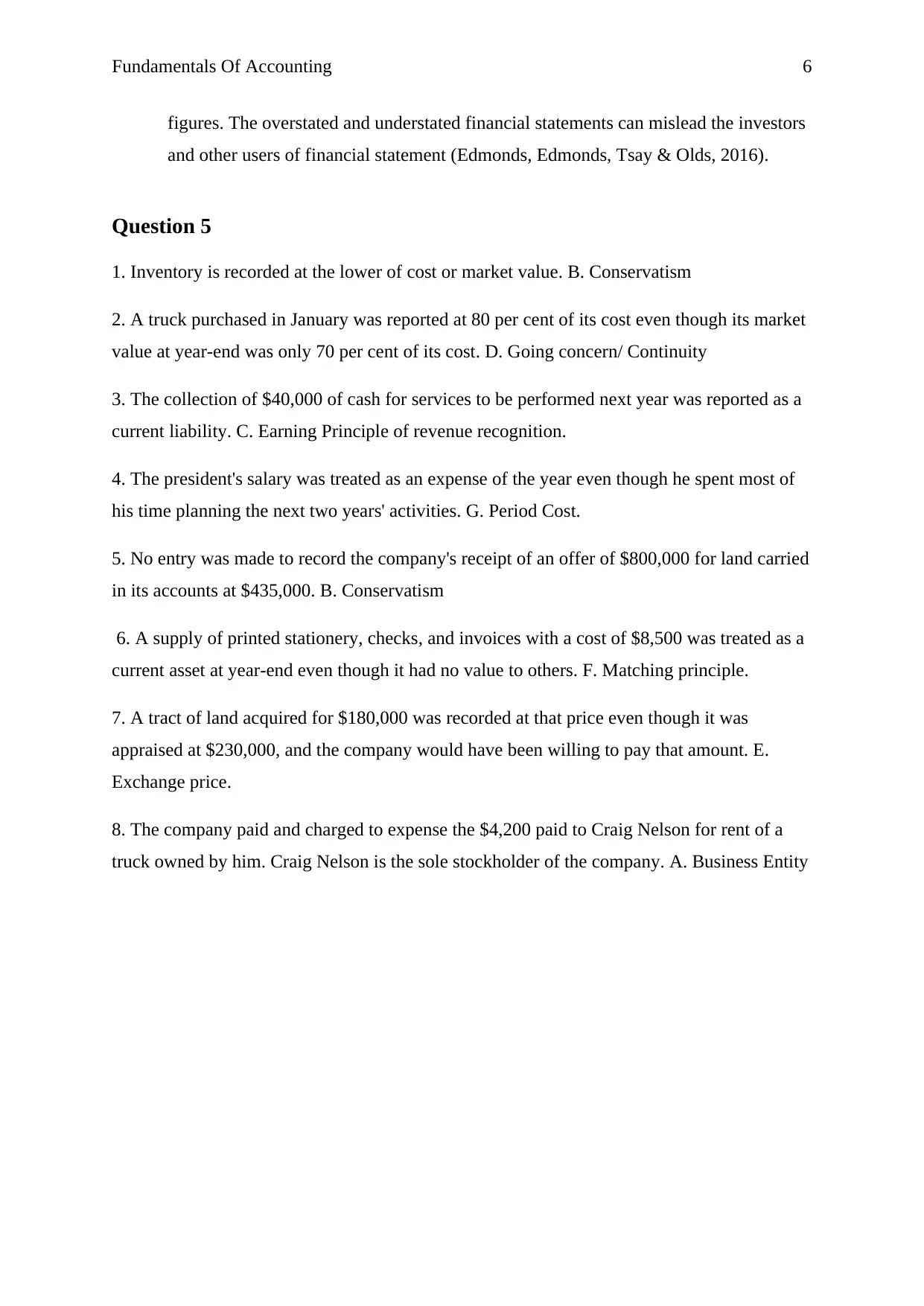
Fundamentals Of Accounting 6
figures. The overstated and understated financial statements can mislead the investors
and other users of financial statement (Edmonds, Edmonds, Tsay & Olds, 2016).
Question 5
1. Inventory is recorded at the lower of cost or market value. B. Conservatism
2. A truck purchased in January was reported at 80 per cent of its cost even though its market
value at year-end was only 70 per cent of its cost. D. Going concern/ Continuity
3. The collection of $40,000 of cash for services to be performed next year was reported as a
current liability. C. Earning Principle of revenue recognition.
4. The president's salary was treated as an expense of the year even though he spent most of
his time planning the next two years' activities. G. Period Cost.
5. No entry was made to record the company's receipt of an offer of $800,000 for land carried
in its accounts at $435,000. B. Conservatism
6. A supply of printed stationery, checks, and invoices with a cost of $8,500 was treated as a
current asset at year-end even though it had no value to others. F. Matching principle.
7. A tract of land acquired for $180,000 was recorded at that price even though it was
appraised at $230,000, and the company would have been willing to pay that amount. E.
Exchange price.
8. The company paid and charged to expense the $4,200 paid to Craig Nelson for rent of a
truck owned by him. Craig Nelson is the sole stockholder of the company. A. Business Entity
figures. The overstated and understated financial statements can mislead the investors
and other users of financial statement (Edmonds, Edmonds, Tsay & Olds, 2016).
Question 5
1. Inventory is recorded at the lower of cost or market value. B. Conservatism
2. A truck purchased in January was reported at 80 per cent of its cost even though its market
value at year-end was only 70 per cent of its cost. D. Going concern/ Continuity
3. The collection of $40,000 of cash for services to be performed next year was reported as a
current liability. C. Earning Principle of revenue recognition.
4. The president's salary was treated as an expense of the year even though he spent most of
his time planning the next two years' activities. G. Period Cost.
5. No entry was made to record the company's receipt of an offer of $800,000 for land carried
in its accounts at $435,000. B. Conservatism
6. A supply of printed stationery, checks, and invoices with a cost of $8,500 was treated as a
current asset at year-end even though it had no value to others. F. Matching principle.
7. A tract of land acquired for $180,000 was recorded at that price even though it was
appraised at $230,000, and the company would have been willing to pay that amount. E.
Exchange price.
8. The company paid and charged to expense the $4,200 paid to Craig Nelson for rent of a
truck owned by him. Craig Nelson is the sole stockholder of the company. A. Business Entity
⊘ This is a preview!⊘
Do you want full access?
Subscribe today to unlock all pages.

Trusted by 1+ million students worldwide
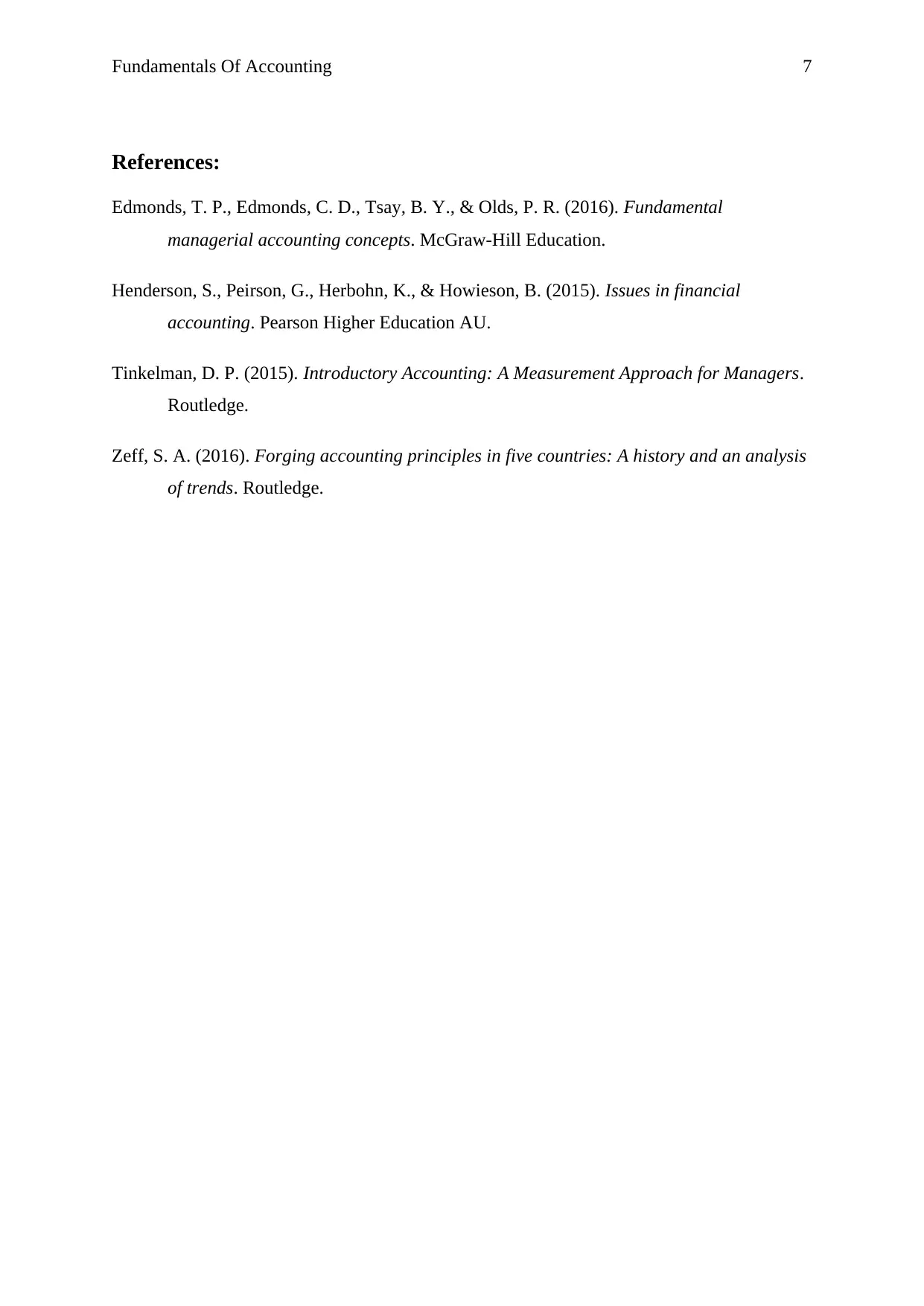
Fundamentals Of Accounting 7
References:
Edmonds, T. P., Edmonds, C. D., Tsay, B. Y., & Olds, P. R. (2016). Fundamental
managerial accounting concepts. McGraw-Hill Education.
Henderson, S., Peirson, G., Herbohn, K., & Howieson, B. (2015). Issues in financial
accounting. Pearson Higher Education AU.
Tinkelman, D. P. (2015). Introductory Accounting: A Measurement Approach for Managers.
Routledge.
Zeff, S. A. (2016). Forging accounting principles in five countries: A history and an analysis
of trends. Routledge.
References:
Edmonds, T. P., Edmonds, C. D., Tsay, B. Y., & Olds, P. R. (2016). Fundamental
managerial accounting concepts. McGraw-Hill Education.
Henderson, S., Peirson, G., Herbohn, K., & Howieson, B. (2015). Issues in financial
accounting. Pearson Higher Education AU.
Tinkelman, D. P. (2015). Introductory Accounting: A Measurement Approach for Managers.
Routledge.
Zeff, S. A. (2016). Forging accounting principles in five countries: A history and an analysis
of trends. Routledge.
1 out of 7
Related Documents
Your All-in-One AI-Powered Toolkit for Academic Success.
+13062052269
info@desklib.com
Available 24*7 on WhatsApp / Email
![[object Object]](/_next/static/media/star-bottom.7253800d.svg)
Unlock your academic potential
Copyright © 2020–2025 A2Z Services. All Rights Reserved. Developed and managed by ZUCOL.




